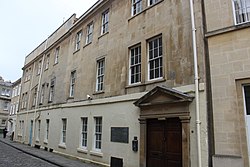
Bath is a city in the ceremonial county of Somerset in England, known for and named after its Roman-built baths. At the 2021 Census, the population was 94,092. Bath is in the valley of the River Avon, 97 miles (156 km) west of London and 11 miles (18 km) southeast of Bristol. The city became a UNESCO World Heritage Site in 1987, and was later added to the transnational World Heritage Site known as the "Great Spa Towns of Europe" in 2021. Bath is also the largest city and settlement in Somerset.
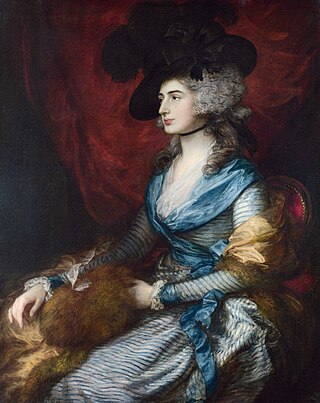
Sarah Siddons was a Welsh actress, the best-known tragedienne of the 18th century. Contemporaneous critic William Hazlitt dubbed Siddons as "tragedy personified".

The Royal Crescent is a row of 30 terraced houses laid out in a sweeping crescent in the city of Bath, England. Designed by the architect John Wood, the Younger, and built between 1767 and 1774, it is among the greatest examples of Georgian architecture to be found in the United Kingdom and is a Grade I listed building. Although some changes have been made to the various interiors over the years, the Georgian stone facade remains much as it was when first built.

Bristol Old Vic is a British theatre company based at the Theatre Royal, Bristol. The present company was established in 1946 as an offshoot of the Old Vic in London. It is associated with the Bristol Old Vic Theatre School, which became a financially independent organisation in the 1990s. Bristol Old Vic runs a Young Company for those aged 7–25.
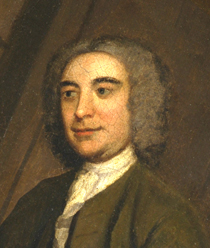
John Wood, the Elder was an English architect, working mainly in Bath.
Henry Edmund Goodridge was an English architect based in Bath. He worked from the early 1820s until the 1850s, using Classical, Italianate and Gothic styles.

The Grand Lodge of Ireland is the second most senior Grand Lodge of Freemasons in the world, and the oldest in continuous existence. Since no specific record of its foundation exists, 1725 is the year celebrated in Grand Lodge anniversaries, as the oldest reference to Grand Lodge of Ireland comes from the Dublin Weekly Journal of 26 June 1725. This describes a meeting of the Grand Lodge to install the new Grand Master, The 1st Earl of Rosse, on 24 June. The Grand Lodge has regular Masonic jurisdiction over 13 Provincial Grand Lodges covering all the Freemasons of the island of Ireland, and another 11 provinces worldwide.

The Bath Assembly Rooms, designed by John Wood the Younger in 1769, are a set of assembly rooms located in the heart of the World Heritage City of Bath in England which are now open to the public as a visitor attraction. They are designated as a Grade I listed building.

Persuasion is a BBC Screen Two 1995 period drama film directed by Roger Michell and based on Jane Austen's 1817 novel of the same name. In her theatrical film debut, Amanda Root stars as protagonist Anne Elliot, while Ciarán Hinds plays her romantic interest, Captain Frederick Wentworth. The film is set in early 19th-century England, eight years after Anne was persuaded by others to reject Wentworth's proposal of marriage. Persuasion follows the two as they become reacquainted with each other while supporting characters threaten to interfere.

The Theatre Royal in Bath, England, was built in 1805. A Grade II* listed building, it has been described by the Theatres Trust as "One of the most important surviving examples of Georgian theatre architecture". It has a capacity for an audience of around 900.

Somerset is a county in the south west of England. It has a varied cultural tradition ranging from the Arthurian legends to The Wurzels, a band specialising in Scrumpy and Western music.

John Palmer of Bath was a theatre owner and instigator of the British system of mail coaches that was the beginning of the great British post office reforms with the introduction of an efficient mail coach delivery service in Great Britain during the late 18th century. He was Mayor of Bath on two occasions and Comptroller General of the Post Office, and later served as Member of Parliament for the constituency of Bath between 1801 and 1807.
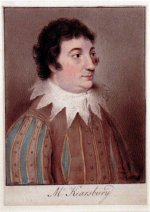
William Keasberry, sometimes spelt Keasbury, was an English actor and theatre manager of the 18th century whose career was chiefly in Bath, Somerset.

John Henderson (1747–1785) was an English actor who played many Shakespearean and other roles. He first acted in Bath, where he was known as "The Bath Roscius", and then in London. Had he not died young he would have been remembered as a worthy successor to David Garrick.

The Masonic Hall is a grade II listed building on Monk Street in Monmouth, Monmouthshire, Wales. It was designed by architect George Vaughan Maddox. The building is believed to mark the site of Monk's Gate, part of the original defences of the town of Monmouth. Before its 1846 conversion to the Masonic Hall, the building served as the Monk Street Theatre. After more than 150 years of housing the Loyal Monmouth Lodge No. 457, the Masonic Hall sustained fire and smoke damage from suspected arson. The Lodge of Freemasons housed in the building is the oldest surviving Masonic Lodge in Monmouthshire.

The following is a timeline of the history of the city of Bath, Somerset, England.
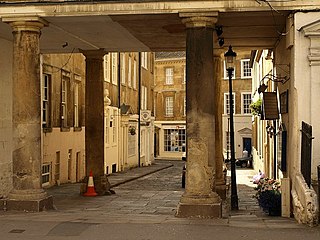
Pierrepont Place is a mews street in Bath, England. Records indicate that Pierrepont Place and properties on it were built by John Wood the Elder between 1732 and 1748, on land once belonging to monks of Bath Abbey, who had used it as an orchard.
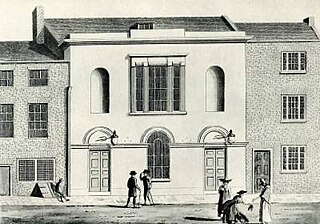
The Theatre Royal, Southampton was a theatre in Southampton, Hampshire, England. It opened in 1803 and was located near the Medieval Merchant's House on French Street. Jane Austen and her family visited the theatre in 1807. The building was later renovated and expanded, and reopened as New Theatre Royal in 1880. It was destroyed by a fire in 1884.

William Wyatt Dimond was an actor and theatre manager of the late 18th-century whose career was largely based in Bath in Somerset.
